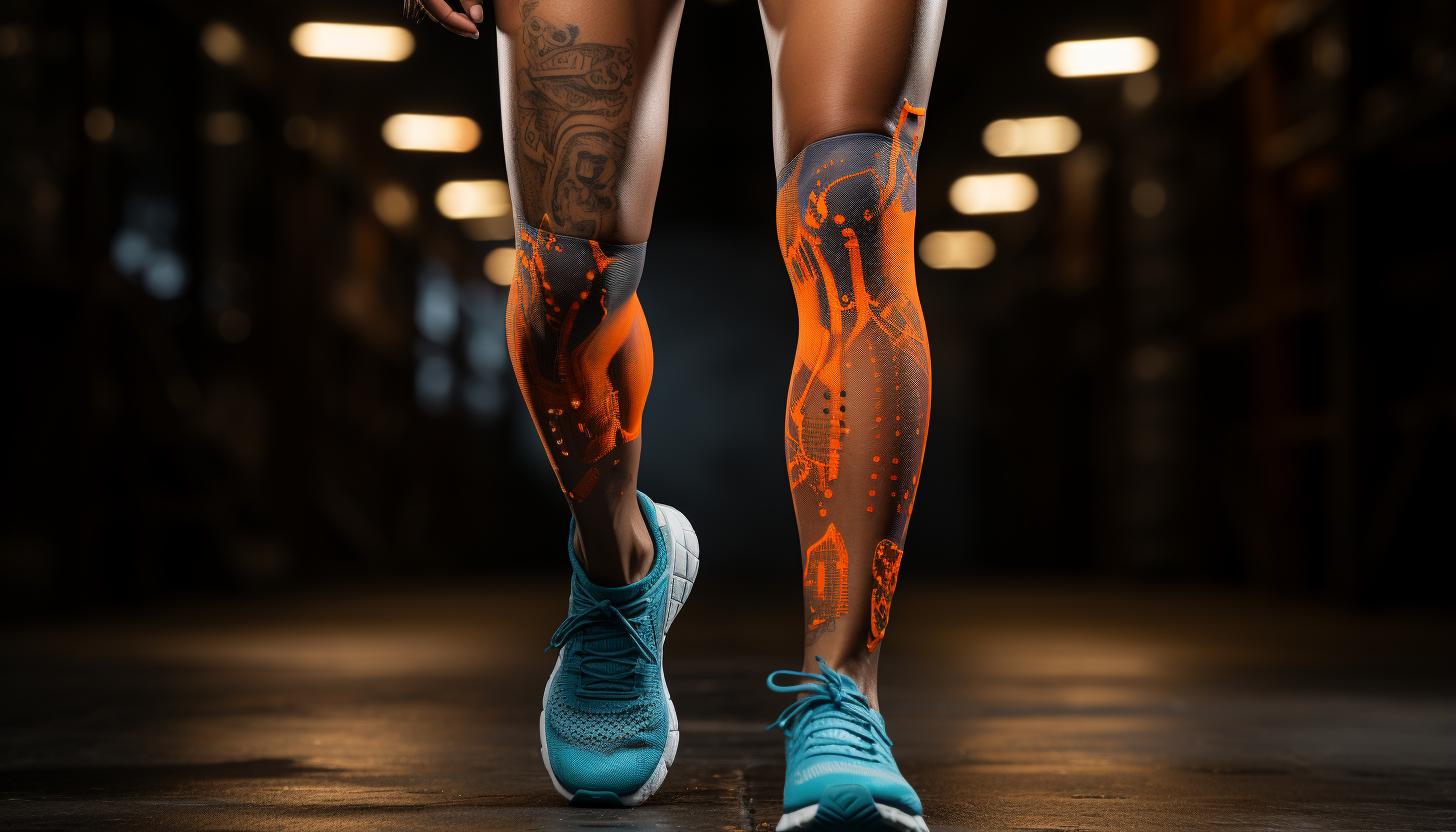The Benefits of Compression Gear for Runners

Did you know that wearing compression gear can enhance your running performance and reduce the risk of injuries? According to recent studies, runners who use compression gear experience improved circulation, enhanced muscle support, reduced fatigue, and faster recovery.
These benefits can lead to increased endurance and better overall performance. In this article, we will delve into the evidence-based benefits of compression gear for runners, providing you with valuable insights to help you take your running game to the next level.
Improved Circulation and Oxygen Delivery

Compression gear can help you, as a runner, by improving circulation and oxygen delivery to your muscles. This is crucial for improved athletic performance and injury prevention. When you engage in high-intensity activities like running, your muscles require an adequate supply of oxygen to function optimally. Compression garments work by applying gentle pressure to the limbs, which helps promote blood flow and venous return. As a result, more oxygen-rich blood reaches your muscles, providing them with the necessary nutrients and removing waste products efficiently.
Studies have shown that wearing compression gear during exercise can lead to enhanced circulation and oxygenation of the muscles. This increased delivery of oxygen can improve your endurance capacity, allowing you to run longer distances or maintain a faster pace without experiencing excessive fatigue. By optimizing circulation, compression gear also reduces muscle soreness and accelerates recovery post-workout.
Incorporating compression gear into your running routine can have significant benefits for both short-term performance and long-term injury prevention. The improved circulation not only enhances athletic performance but also helps reduce muscle damage caused by repetitive impact during running. By minimizing muscle oscillation and vibration, compression clothing provides enhanced muscle support and stability.
Transitioning into the next section about ‘enhanced muscle support and stability,’ we will explore how compression gear aids in preventing injuries during running further.
Enhanced Muscle Support and Stability

Wearing compression gear helps you, as a runner, by providing improved muscle support and stability during your workouts. This enhanced support can have several benefits for your performance and injury prevention.
Compression gear works by applying gentle pressure to specific areas of your body, such as the calves, thighs, and hips. This pressure helps to compress the muscles, reducing muscle vibration and micro-tears that can occur during exercise. By stabilizing the muscles, compression gear can improve your overall movement efficiency and reduce the risk of fatigue-related injuries.
In addition to muscle support, compression gear also promotes better blood flow. The tight fit of the garments helps to increase circulation, delivering more oxygen-rich blood to your working muscles. This increased oxygen delivery can enhance your endurance and delay the onset of fatigue.
To understand how compression gear benefits runners in terms of enhanced performance and injury prevention further, let’s take a look at this table:
| Benefit | Enhanced Performance | Injury Prevention |
|---|---|---|
| Improved Muscle Support | ✓ | ✓ |
| Stabilizes Muscles | ✓ | ✓ |
| Enhances Blood Flow | ✓ |
As you can see from the table above, wearing compression gear provides both enhanced performance benefits and injury prevention advantages for runners. So why not give it a try next time you hit the pavement?
Reduced Muscle Fatigue and Soreness

When you incorporate compression gear into your running routine, you’ll notice a significant reduction in muscle fatigue and soreness. Here’s why compression gear is so effective in preventing cramps and minimizing lactic acid buildup:
1. Increased Blood Circulation: Compression garments provide graduated pressure to the muscles, which helps improve blood flow during exercise. This enhanced circulation facilitates the delivery of oxygen and nutrients to your muscles while removing waste products like lactic acid more efficiently.
2. Reduced Muscle Vibration: The tight fit of compression gear limits excessive muscle oscillation during high-impact activities like running. By minimizing these vibrations, compression garments help reduce micro-tears in the muscle fibers that can contribute to post-workout soreness.
3. Enhanced Muscular Support: Compression garments offer targeted support to specific muscle groups, such as the calves and quadriceps. This support helps stabilize the muscles, reducing fatigue and lowering the risk of injury.
Studies have shown that wearing compression gear during exercise can lead to decreased levels of perceived exertion and faster recovery times after intense workouts or races. So if you want to experience reduced muscle fatigue and soreness while running, give compression gear a try!
Faster Recovery and Injury Prevention

By incorporating compression gear into your routine, you’ll notice faster recovery times and a reduced risk of injuries. Compression gear has been shown to aid in muscle recovery by improving blood circulation and decreasing inflammation.
When you engage in intense physical activity, such as running, your muscles undergo stress and micro-tears occur. This results in soreness and fatigue. However, wearing compression gear helps increase the flow of oxygen-rich blood to your muscles, which speeds up the removal of metabolic waste products like lactic acid. As a result, your muscles recover more quickly and feel less fatigued after exercise.
Additionally, compression gear provides support to your muscles and joints, reducing the risk of injuries. It helps stabilize the muscles while they are under strain, preventing excessive movement that can lead to strains or sprains. The snug fit of compression garments also provides proprioceptive feedback to your body, increasing awareness of muscle position and movement during exercise.
With faster recovery times and injury prevention through the use of compression gear, you can train more consistently without interruptions due to muscle soreness or injury setbacks. This allows for increased performance and endurance during workouts or races.
Next, we will explore how compression gear further enhances your athletic abilities with improved performance and stamina.
Increased Performance and Endurance

Using compression gear can help you improve your performance and endurance levels. Here are three ways how:
1. Improved Aerobic Capacity: Compression gear provides graduated pressure to the muscles, which helps increase blood flow and oxygen delivery. This enhanced circulation allows your body to efficiently deliver oxygen to working muscles, improving your aerobic capacity. With more oxygen available, you’ll be able to push yourself further and maintain a higher intensity for longer periods.
2. Increased Speed: Compression gear has been shown to enhance proprioception, or the awareness of your body’s position in space. By providing gentle pressure and support to the muscles, compression garments can enhance muscle coordination and control during movements. This improved neuromuscular feedback can lead to increased speed as you optimize your running mechanics.
3. Enhanced Agility: Compression gear also offers joint stability and support, which can improve agility on the field or track. The compression fabric helps reduce muscle vibrations and soft tissue damage during quick direction changes or sudden stops, allowing you to move with more confidence and precision.
Conclusion
In conclusion, wearing compression gear while running can provide numerous benefits. It improves circulation and oxygen delivery, allowing muscles to perform at their best. The enhanced muscle support and stability offered by compression gear reduces fatigue and soreness, enabling you to push yourself further. Wearing compression gear also promotes faster recovery and prevents injuries. Ultimately, this leads to increased performance and endurance on the track or trail.
Remember the adage: “No pain, no gain.” So why not give compression gear a try and see the difference it can make in your running journey?
